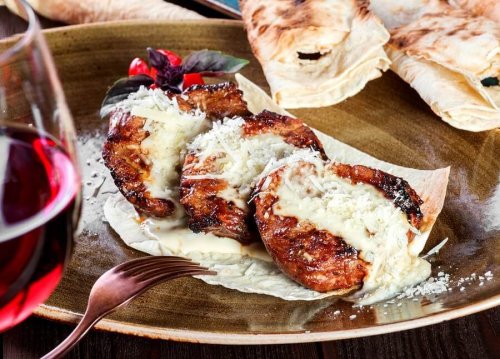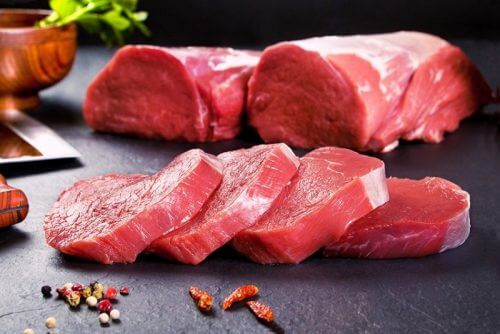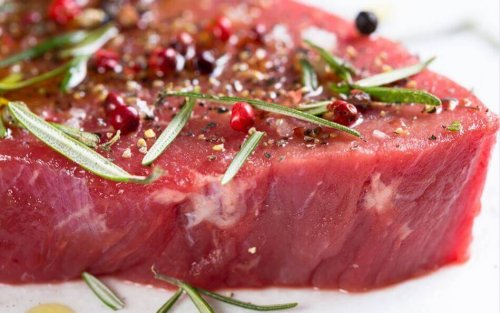Parmesan Veal Steaks, an Easy Recipe

Today, we’ll tell you about a rather unique recipe: Parmesan veal steaks. As you probably already know, veal is highly nutritious. It’s produced from the male offspring of dairy cows and is very popular for its texture and easy digestion. Here, discover how to prepare it and learn about its remarkable nutritional values.
The Health Properties of Veal
Veal is a type of beef in which the young animal doesn’t grow to be a year old. Hence its name, as the texture of the flesh is tender (from Anglo-Norman French ve(e)l and from Latin vitellus, diminutive of vitulus “calf”).
In general, these calves feed on grass and grains, and this gives veal its characteristic pinkish color. It has a high content of nutrients, all of which are essential for the optimal functioning of your body.
However, it should be consumed in moderation, especially if its consumption conflicts with certain conditions, as per your doctor’s advice.
Some facts about veal:
- It’s rich in minerals such as iron, potassium, phosphorus, and sodium.
- Veal is a good source of vitamins of the B, E and K complex.
- It contains saturated fat, so you should control its consumption.
The Properties of Parmesan Cheese

Parmesan cheese is one of the main ingredients in the preparation of some foods that, prior to frying or baking, are coated with it.
Cheese is the perfect ingredient to have around for the preparation of Parmesan veal steaks. It’s rich in protein, calcium, phosphorus, iron, linoleic acid, and vitamins A and D.
Now it’s the time to try something new and innovative like this dish. It’s a tasty homemade recipe that will delight anyone fortunate enough to be sitting at your dinner table!
Parmesan Veal Steaks

Veal steaks are classified according to the cut: There’s sirloin steak (where fillets come from), loin chops and tenderloin, and topside.
However, you can just buy a chunk of sirloin and slice it yourself so that your steaks are as thick or thin as you want them. Of course, you can also ask your butcher to slice them for you right then.
Ingredients
- 1 c. of red wine
- 4 cloves garlic, crushed
- 1 tbsp of salt
- ½ tbsp of pepper
- 1 tbsp thyme powder
- 6 veal sirloin steaks
- Wrapping paper
- ¼ c. whole milk
- 2 eggs
- 1 c. of bread crumbs
- ¼ c. of olive oil
- Absorbent paper
- 1 c. of mozzarella cheese
- ½ c. of Parmesan cheese
- Aluminum foil
- A twig of basil for garnish
Read this article: 3 Ways to Marinate Meat
Preparation of the Marinade

To obtain the best flavor out of any cut of meat as you cook it, be it grilled, fried or baked, you should first marinate and refrigerate it for a couple of hours. You should also grill the Parmesan cheese in the oven for a few minutes.
- First, pour the red wine on a deep baking dish.
- Next, add the crushed garlic cloves, salt, pepper, and thyme powder.
- Then, add the veal steaks and give them a few turns so they absorb the wine and spices mixture.
- Finally, cover with some wrapping paper and refrigerate for at least 2 hours before you cook them.
Preparation of Parmesan Veal Steaks
- First, preheat the oven to 350 or 375°F.
- Then, mix the eggs with the milk on a shallow bowl (you can add a little more salt if you wish). Separately, pour the bread crumbs on a flat plate for the breading step.
- Next, remove the steaks from the refrigerator and pass each one through the egg and milk mixture and then bread them.
- Then, set aside the marinade mixture for an upcoming step.
- Further, heat a pan with olive oil and fry the steaks one by one for about 5 minutes or until golden brown.
- Afterward, remove each steak from the oil and place it on a paper towel to take off some of the extra oil.
- Then, dip each steak in the marinate mixture. After, arrange them on the baking dish so that they all fit in it. Top them with the Parmesan and mozzarella cheeses.
- Cover the dish with aluminum foil and bring into the preheated oven for about 10 minutes.
- Finally, after the 10 minutes are up, remove the dish from the oven. Let cool down a bit before you serve it with pasta or salad. Garnish with basil.
All cited sources were thoroughly reviewed by our team to ensure their quality, reliability, currency, and validity. The bibliography of this article was considered reliable and of academic or scientific accuracy.
- Carretto, V. ;, Cuerdo, P. ;, Dirienzo, G. ;, Di, V., & Victoria, M. (2002). Aceite de oliva: beneficios en la salud. Invenio, 5(8), 141–149. Retrieved from http://www.redalyc.org/articulo.oa?id=87750812
- Gutiérrez Maydata, A. (2002). Vino, polifenoles y protección a la salud. Revista Cubana Aliment Nutr, 16(2), 134–175. Retrieved from http://bvs.sld.cu/revistas/ali/vol16_2_02/ali07202.pdf
This text is provided for informational purposes only and does not replace consultation with a professional. If in doubt, consult your specialist.








